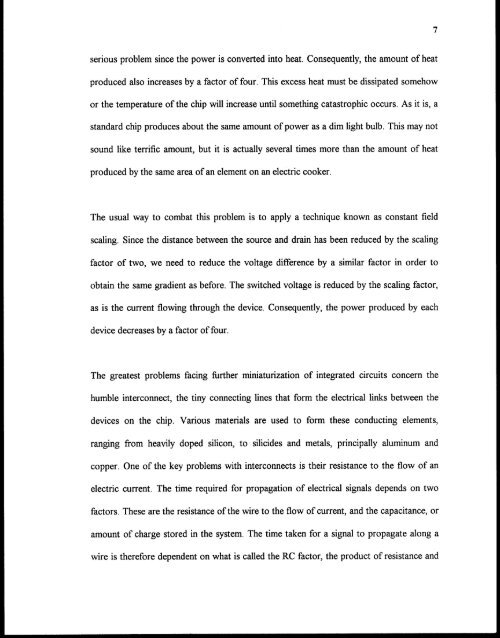njit-etd2000-029 - New Jersey Institute of Technology
njit-etd2000-029 - New Jersey Institute of Technology
njit-etd2000-029 - New Jersey Institute of Technology
You also want an ePaper? Increase the reach of your titles
YUMPU automatically turns print PDFs into web optimized ePapers that Google loves.
7<br />
serious problem since the power is converted into heat. Consequently, the amount <strong>of</strong> heat<br />
produced also increases by a factor <strong>of</strong> four. This excess heat must be dissipated somehow<br />
or the temperature <strong>of</strong> the chip will increase until something catastrophic occurs. As it is, a<br />
standard chip produces about the same amount <strong>of</strong> power as a dim light bulb. This may not<br />
sound like terrific amount, but it is actually several times more than the amount <strong>of</strong> heat<br />
produced by the same area <strong>of</strong> an element on an electric cooker.<br />
The usual way to combat this problem is to apply a technique known as constant field<br />
scaling. Since the distance between the source and drain has been reduced by the scaling<br />
factor <strong>of</strong> two, we need to reduce the voltage difference by a similar factor in order to<br />
obtain the same gradient as before. The switched voltage is reduced by the scaling factor,<br />
as is the current flowing through the device. Consequently, the power produced by each<br />
device decreases by a factor <strong>of</strong> four.<br />
The greatest problems facing further miniaturization <strong>of</strong> integrated circuits concern the<br />
humble interconnect, the tiny connecting lines that form the electrical links between the<br />
devices on the chip. Various materials are used to form these conducting elements,<br />
ranging from heavily doped silicon, to silicides and metals, principally aluminum and<br />
copper. One <strong>of</strong> the key problems with interconnects is their resistance to the flow <strong>of</strong> an<br />
electric current. The time required for propagation <strong>of</strong> electrical signals depends on two<br />
factors. These are the resistance <strong>of</strong> the wire to the flow <strong>of</strong> current, and the capacitance, or<br />
amount <strong>of</strong> charge stored in the system. The time taken for a signal to propagate along a<br />
wire is therefore dependent on what is called the RC factor, the product <strong>of</strong> resistance and
















